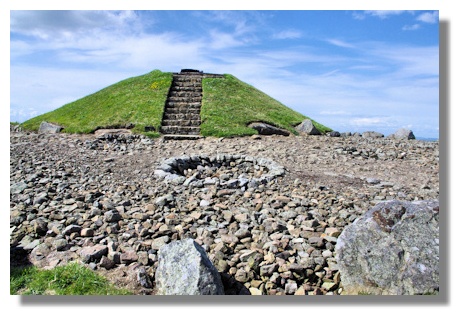
Places to Visit in Scotland
- Cairnpapple Hill, West Lothian

5,000 Years Ago
There are traces of people living in the area of Cairnpapple Hill (a few miles north of Bathgate in East Lothian and 17 miles west of the centre of present day Edinburgh) around 5,500 years ago. These Neolithic farmers left behind pottery and axes (perhaps surprisingly, these originated in Wales and in Cumbria in the north of England) and the remains of fires have been found on the site. Cairnpapple Hill is a prominent feature of the Bathgate Hills, with great views of the surrounding countryside to the west and east and especially to the north, across the river Forth and into Fife. The farmers 5,000 years ago cultivated with wooden spades and hoes and planted cereal crops as well hunting and fishing. Their houses were probably built of timber with turf roofs.
Building a Henge Monument
Around 3,000BC the people who farmed there began to build a "henge", probably for ceremonial purposes. The henge was similar to others in other parts of Britain and consisted of a circle of 24 massive upright wooden posts surrounded by a bank and a ditch. Originally it had two entrances leading to the centre. The henge is 60 metres (nearly 200 feet) in diameter and there was a ditch over a metre (three feet) deep.
In those days, the climate in Scotland was milder than today and early agriculture would have produced a good supply of food, allowing them to devote time and energy to building their monuments. But there are no signs of any houses nearby so the initial construction must have had some important ceremonial purpose, long forgotten. We know little about the people who built these monuments and why they did so.
Burials at Cairnpapple
During the later Bronze Age, around 2000BC, the use of the site moved gradually from being largely ceremonial to a place of burial when a large grave was created, covered by a cairn of stones.This impressive relic measures 10 feet (3.3 metres) long by nearly 9 feet (2.7 metres) wide with a massive upright stone around 8 feet (2.4 metres) high. The human remains found there during archaeological excavations in the late 1940s, showed that the body had been laid out full length and had probably been wrapped in organic material and two distinctively decorated pots known as beakers had been left full of food and drink. This grave was originally covered by a cairn of stones. In recent times, partly to provide protection from the weather, a modern dome has been built above the grave and a steep metal ladder provides access for visitors.
Later Burials
There are signs of other burials near the large grave, including two with large stones above them. Objects buried with the bodies included metal ones imported from Europe, indicating not just the extent of trade but the importance of those who had been buried at Cairnpapple.
A last burial cairn was constructed over the earlier ones, with a diameter of nearly 100 feet (30 metres). It's not clear what caused the local people to build this large cairn. Most of the stones surrounding the graves and the outside of the dome come from this last cairn
There are four graves on the eastern half of the henge aligned east-west and these are probably of early Christian origin, in the first millennium AD. In modern times, these have been identified with white gravel. These graves had been cut into the rock and in one case coincided with one of the post holes from earlier times. By the time the grave had been dug the posts would have rotted away and the fact that the graves had been dug on the same spot would have been accidental - only modern archaeological methods have identified what is there.
20th Century Developments
Long before the 19th century, the site was totally obscured by trees. During World War II, Cairnpapple Hill was the site of part of the network of sites used to warn of approaching enemy aircraft. A Nissen hut for the service personnel was constructed on this excellent look-out location and the building is still there and is used by Historic Scotland as a visitor centre for the archaeological site. Indeed the Nissen hut is now a "listed building" of architectural interest in its own right! Even more recently, a telecommunications mast has been built to the west of the site, providing mobile phone services, taking advantage of the wide reception area which the location provides. In the late 1940s, archaeological excavations were carried out, uncovering the site but in the process doing a certain amount of damage too.
How to Find Cairnpapple Hill
Cairnpapple Hill is north of Bathgate. If you are going to Cairnpapple from the M8 motorway between Edinburgh and Glasgow, follow the directions for the turn off to Bathgate and look out for the signs for Beecraigs Country Park which is to the north of Cairnpapple. The steep, minor road to Cairnpapple is signposted before reaching Beecraigs. See also the Location Map on Google maps. (You can enlarge the scale of this map, if required).
Return to Index of Places to Visit
Where else would you like to go in Scotland?

